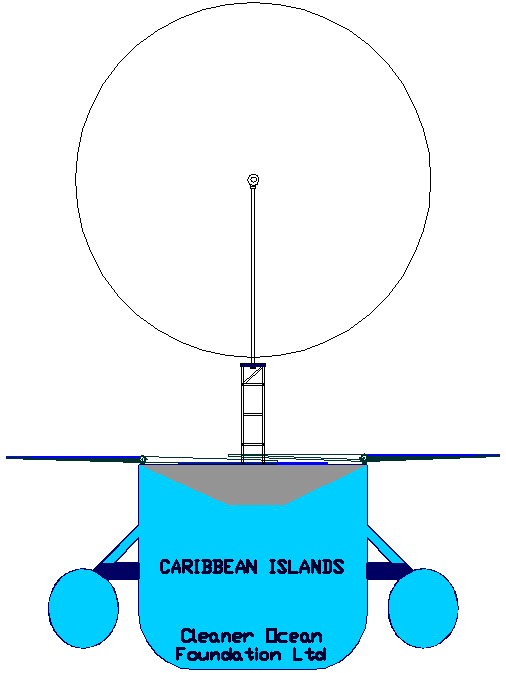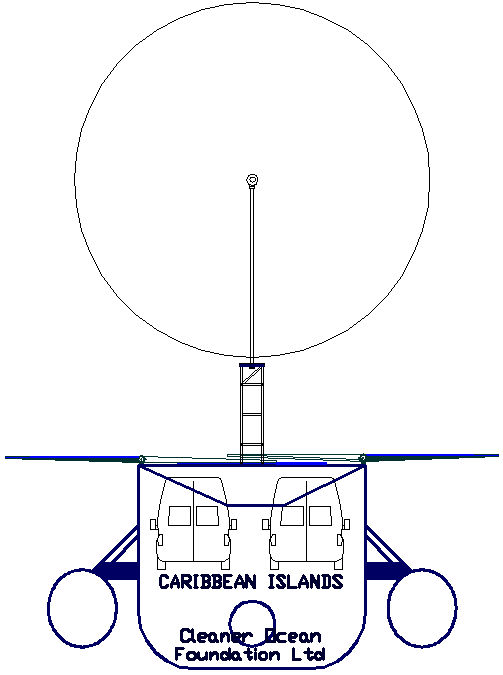|
On
the 4th of May 2012, history was made, as Raphael
Domjan, at the helm of a giant of a
catamaran powered
only by solar panels crossed the finishing line at Monaco to become the
first electric boat to sail around the world. MS Tūranor PlanetSolar, known under the project name
PlanetSolar, is (@ 2014) the largest solar-powered boat in the
world. The vessel was designed by LOMOcean Design, built by Knierim Yachtbau in Kiel,
Germany, and launched on
the 31st March 2010.
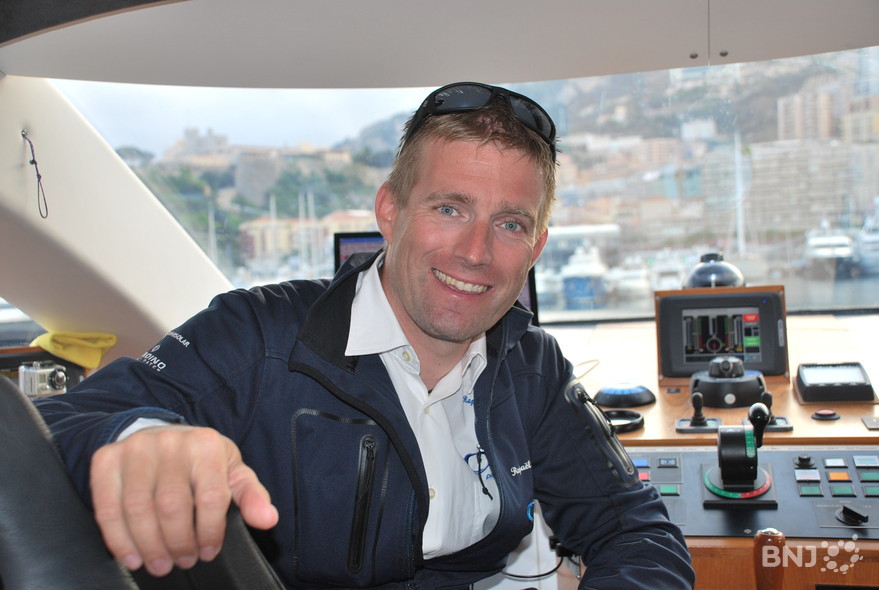
SOLAR
SKIPPER - Raphaėl Domjan at the helm of PlanetSolar.
Technical characteristics
The boat is covered in over 500 square meters of solar panels rated at 93 kW,
which in turn connect to one of the two electric motors in each hull. Although its hull is capable of hosting 200
persons, the shape of the boat means that it is able to reach speeds of up to fourteen
knots. The boat's hull has been model tested in wind tunnels and has been
tank tested to determine the
hydrodynamics and aerodynamics of the hull. This 31 meter long boat has been designed to be used as a luxury
yacht after the record attempt is
finished.
The boat is registered in Switzerland and was financed by a German entrepreneur. Construction cost was
12.5
million. The name Tūranor, derived from J.R.R. Tolkien's novel The Lord of the Rings, translates to "The Power of the
Sun".
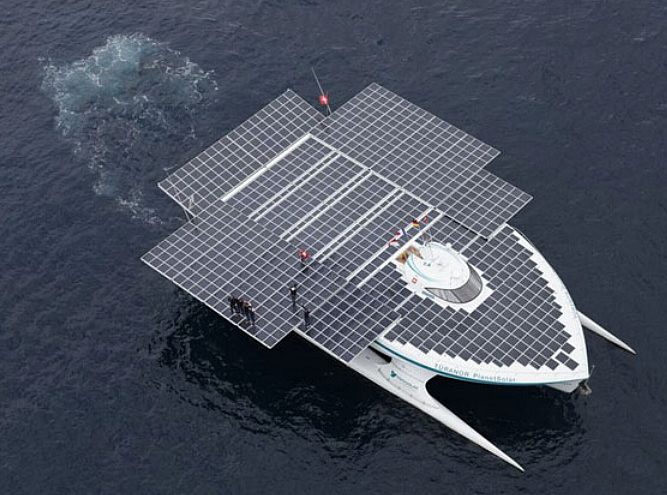
Around the world
On 27 September 2010 Tūranor PlanetSolar started on a journey around the world in Monaco. With this expedition, the
initiators of the project would like to focus the public awareness on the importance of renewable energies for environmental protection. The crew of six will
circumnavigate the globe solely with the aid of solar power. Captain of the expedition is Frenchman Patrick Marchesseau. Other participants are Christian Ochsenbein (Bern, Switzerland) and Jens Langwasser (Kiel, Germany); as well as project initiator, president and expedition leader
Raphaėl Domjan (Neuchatel, Switzerland). On 27 November 2010 the solar boat reached Miami. A significant stopover was Cancśn, during the
United Nations World Climate Conference.
At the centerline of the world tour, the French Canadian Captain Erwann Le Rouzic took over in New Caledonia mid May 2011, for the further circumnavigation sharing the master's responsibility with Captain Patrick Marchesseau.
On the first solar boat expedition around the globe, the Tūranor PlanetSolar has reached two records: fastest crossing of the
Atlantic Ocean by
solar boat and longest distance ever covered by a solar electric vehicle.
After 584 days, Tūranor PlanetSolar returned to Monaco on 4 May 2012
having sailing around the globe. Technical problems with the
propeller system had forced the vessel to stay in an Asian port for two weeks of maintenance. The vessels is now scheduled for a refit so it can be chartered to tourists in the
Mediterranean Sea. Cruises are planned with 12 passengers and 4 crew on board.
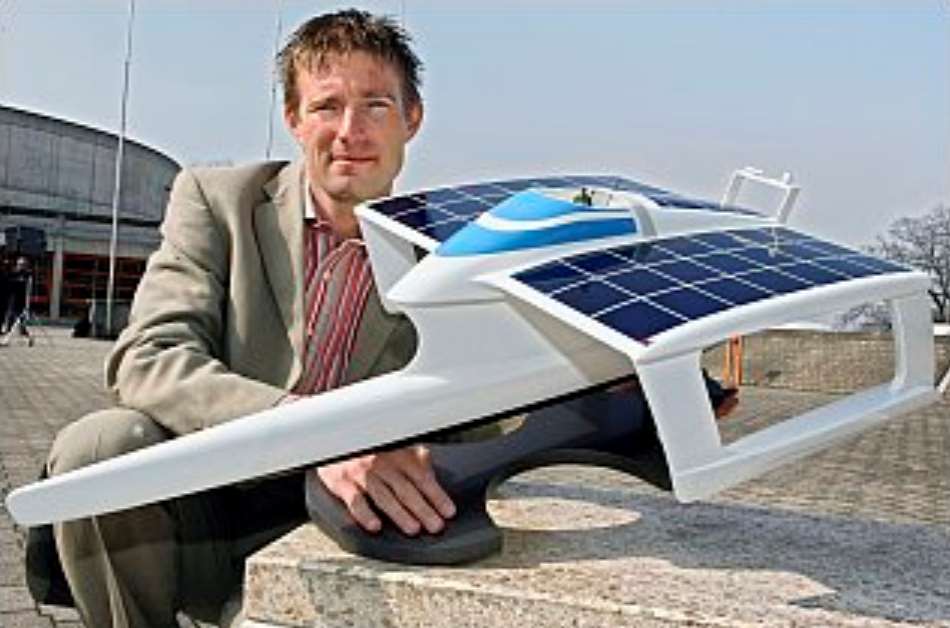
LOMOcean
Design
It all started with the wave piercing trimaran model that Raphael is
holding above. Then the project went through a period or re-evaluation and
realised that their original concept might not be such a realistic
proposition, although we do like the look of the vessel (in theory).
Eventually,
the innovative naval architects from New Zealand, LOMOcean Design, (formerly Craig Loomes Design)
were charged to put the ideas in a second catamaran model onto paper.
LOMOcean claim to offer custom boat designs tailored to the specific requirements of each client. The result is an ever expanding range of mono-hull,
catamaran, trimaran and wavepiercer designs for the pleasure, commercial (ferry, tug, crew boat, work boat etc),
military and super yacht markets,
all of which are perfected in towing tanks and wind tunnels. 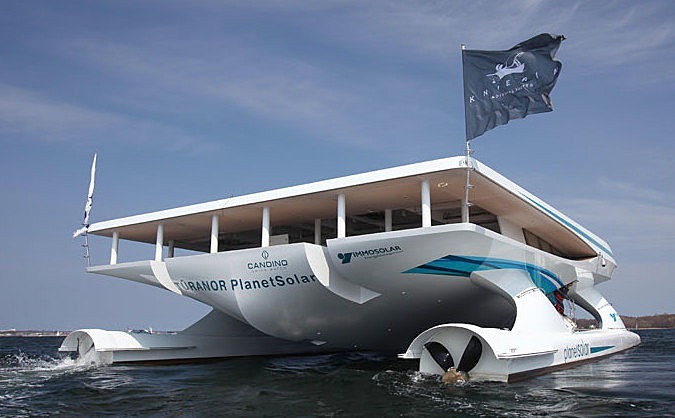
Friday, October 19th
2012 One week after having received the Global +5 Award for our 2013 scientific expedition, we have once again been awarded by the acclaimed Solar Swiss Prize 2012 in the category Persons and Institutions!
The Solar Swiss Prize rewards the individuals and institutions who are the most committed, the best solar buildings and the most beautiful installations.
The 22nd Solar Swiss Prize was held at the Umwelt Arena de Spreitenbach, near Zurich. In this magnificent building, which is completely covered with photovoltaic cells, Raphaėl Domjan,
Immo Stroeher, Pascal Goulpié, Jan-Handrik Stroeher, Christian Ochsenbein and Victor Korewa met to jointly
receive the Solar Swiss Prize 2012 out of thirty other unsuccessful candidates.
Mrs. Eveline Widmer-Schlumpf, President of the Swiss Confederation, honored us with her presence and it is with much pride that we returned home with our trophy and
certificate.
Marseille 2013, European Capital of Culture
The boat, which will be anchored in the Port of Marseille, will put its immense battery capacity and solar
energy at the disposal of the various cultural events organized by the city, notably the StreetMappingSolarShow! This even will take place in 2013!
DeepWaterProject, Scientific mission studying the Gulf Stream
In partnership with the University of
Geneva, the boat will take a team of scientist from Florida to
Iceland, following the
Gulf Stream, in an effort to collect new information and data.
It's the co-winner of the Nobel Peace Prize in 2007 and Professor at the University of Geneva, Martin Beniston, who will head this project.
Besides, the project just received the Global +5 innovation prize rewarded by a jury composed of prestigious members such as Greece former Prime Minister Georgios
Papandréou.
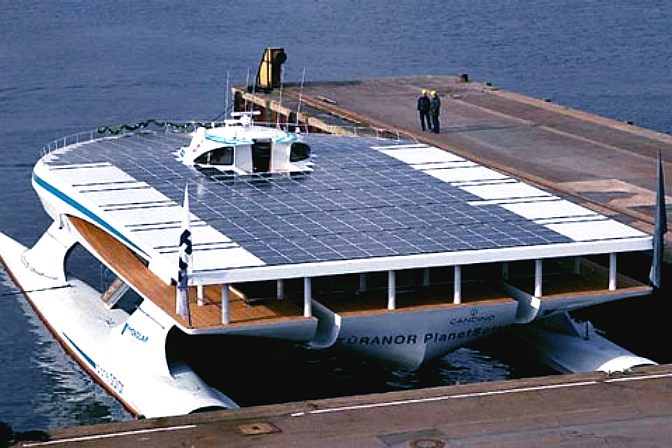
SUMMER
2012 Promotional Tour The summer of 2012 was hot and
Mediterranean for PlanetSolar! The promotional tour started in Marseille where the boat and her crew were guests of honor for the
European Solar Days. During the summer solstice, June 21st, in the famous catalane capital of Barcelona, the ship was moored not far from the monument of
Christopher Columbus and the aquarium. After numerous VIP visits, the crew was invited by the General Consulate of Switzerland in Barcelona to share a typical Catalan meal aboard.
The crew, led by Captain Eric Dumont, headed south in the direction of the Balearic Islands. July 7th, the M/S Tūranor PlanetSolar droped
anchor in the marina of Port Adriano, Calvią, designed by the famous Philippe Stark. During several days our partner Immosolar organized events for the press and public.
July 26th, it was in the Mediterranean island of Sardinia, in Cagliari, that the solar vessel made a stopover and was presented to the public with the support of the local office of tourism.
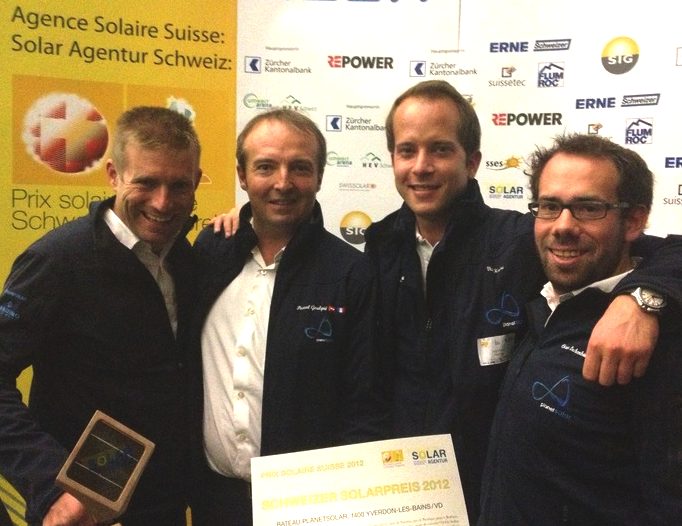
Beginning of August, the crew began the longest leg of the navigational tour, being 4 days, to arrive in the port of San Angelo Wharf of La Valette, in Malte. The stopover on this island, independent from the British Empire since 1964, took place in a tropical atmosphere, with the support of SunPower. The PlanetSolar crew was spellbound.
Next, back up north for a stopover in Carloforte, on the island of San Pietro, southwest of Sardinia. The voyage continued north and stopped over on the Island of Beauty, in the bay of Porto Veccio, on the southwest coast of Corsica. Taking practically the same course as 4 months prior, when PlanetSolar finished her world tour, the ship headed towards
Monaco, in Hercules Port, where she stopped for several days. Finally, the M/S Tūranor PlanetSolar found herself back in La Ciotat, on
September 10th, where she began her makeover! 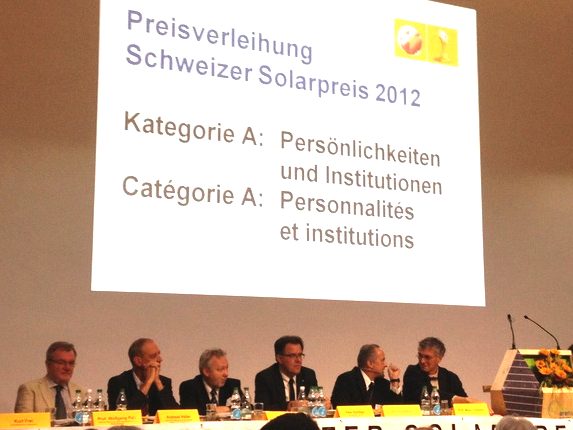
Each stop was not only an opportunity for the PlanetSolar crew to present the futuristic ship to officials, who always welcomed us with enthusiasm, but also to a curious public who were captivated and enthralled by the present day possibilities of solar energy.
The latest city visited was London
in August 2013, with Paris
due in September 2013.
We would like to express our gratitude to the crew who navigated the M/S Tūranor PlanetSolar during her voyage this summer. Thank you Eric Dumont, Thomas David, Etienne Zeitindjioglou, Cyril Guinnard amd Nikita
Dumont-Rey!
http://www.planetsolar.org/newsletter-20121011-en 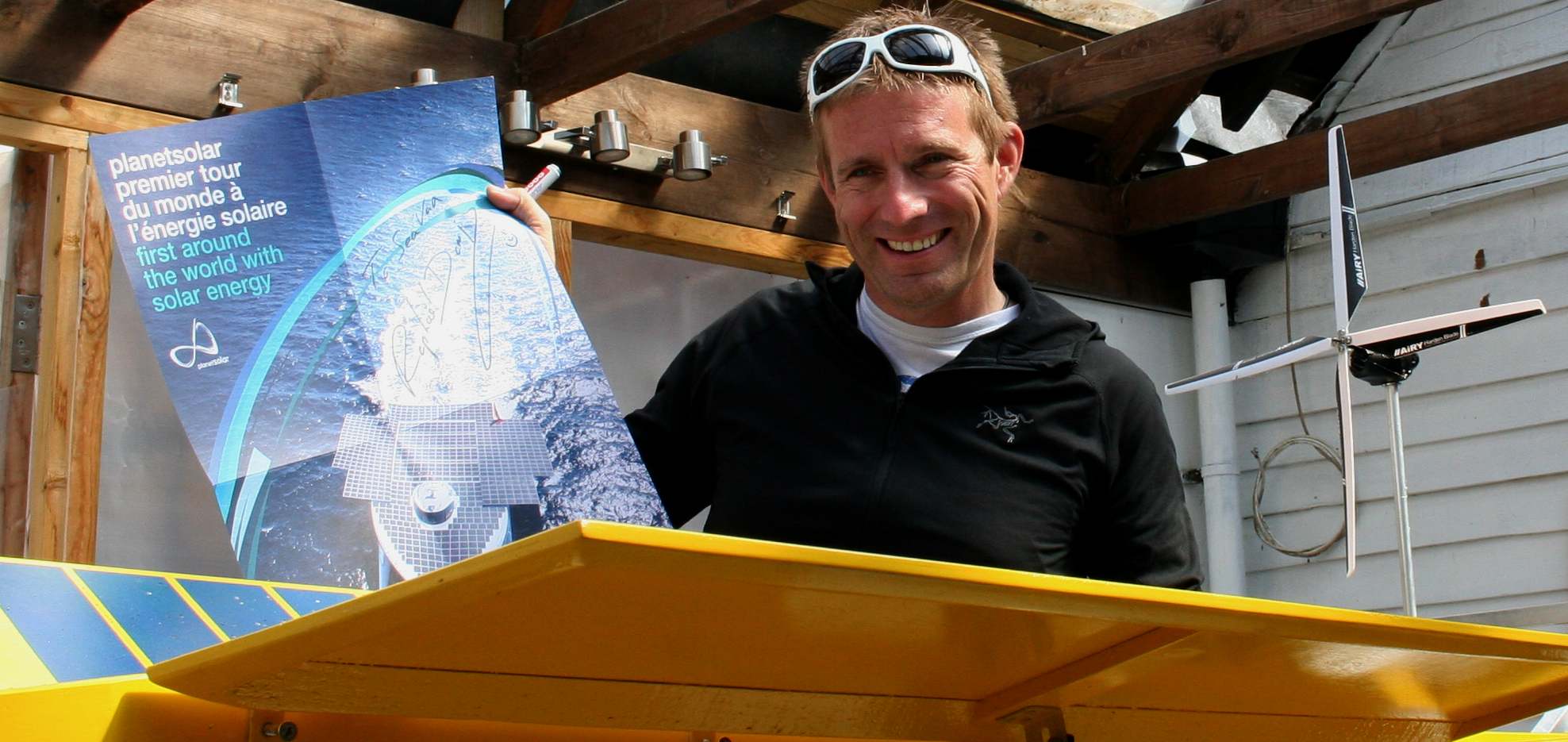
AUGUST
2017 - Raphaėl Domjan is pictured here in the recently built robotics
laboratory in Sussex, England where SeaVax,
also a solar (and wind) powered vessel, is being developed as an ocean
cleaning workboat. He is now working on SolarStratos
in an attempt to use solar power to reach the stratosphere.
A
solar powered sprinter named the Elizabeth
Swan after the Governor's daughter in Pirates of the Caribbean, is
under construction in the UK as a 1/20th scale tank test model, with a
view to proving the concept of a sub 365 day circumnavigation.
The present record stands at 584 days. Copyright photograph © Cleaner
Ocean Foundation August 25 2017.
MONTE
CARLO DISPLAY The
wall mounted map depicts the route of the Planesolar's voyage that started on the 27th September 2010 and finished in Port Hercule, Monaco on Friday.
The wall map and circular water tank were part of a fabulous display to
teach children about the catamaran using practical demonstrations. The
visitors were also allowed onto the vessel itself, so that the theory was
seen to be put into practice. Children and adults enjoyed the teaching facility at Planet Solar. Here children leaned how solar energy
makes electricity to power an electric fan. 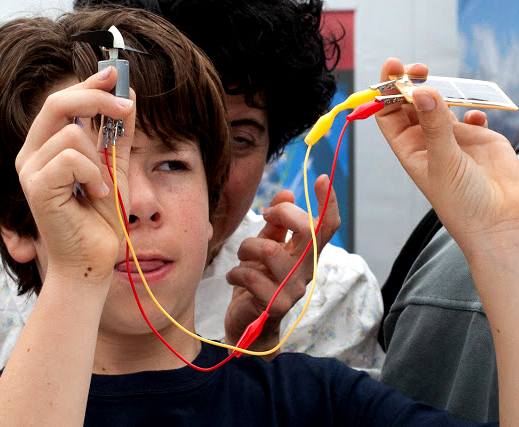
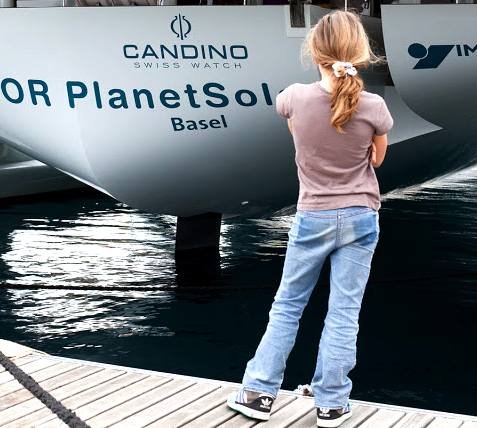
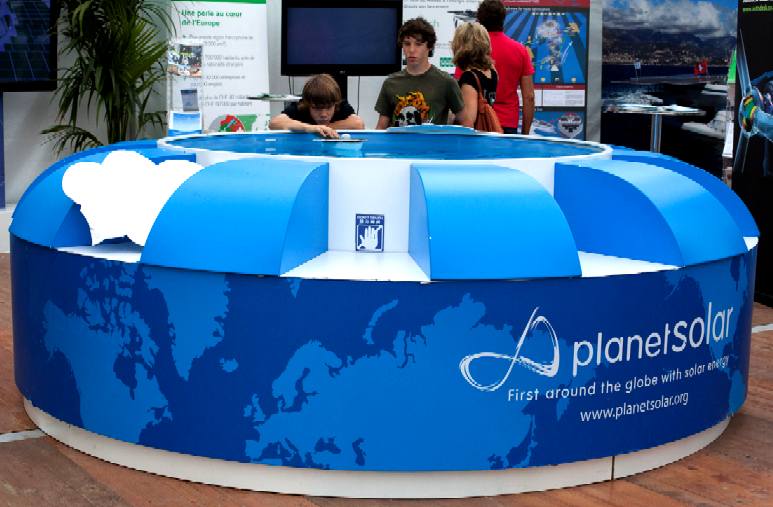
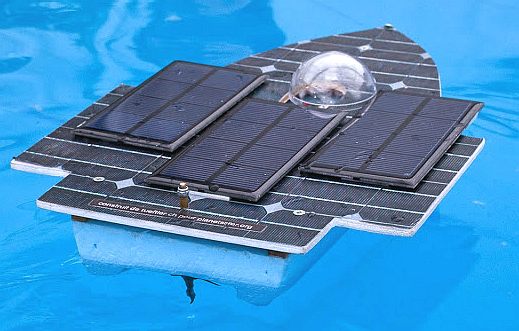

A cut-out cloud is used to demonstrate how solar energy works and when it doesn't - when a cloud passes
over the model it stops working. This small model of the Planetsolar vessel whizzes along in the raised pool
when the cloud is removed, but as soon as the simulated cloud is held over it, it stops.
In real life to prevent the boat stopping like this model, there are batteries on board that store the energy ready for cloudy days and
also to run the ship at night - when of course there is no sunshine. http://www.montecarlodailyphoto.com/2012/05/planet-solar-and-cloud.html
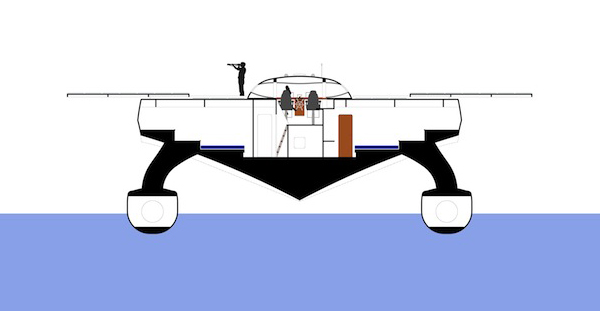
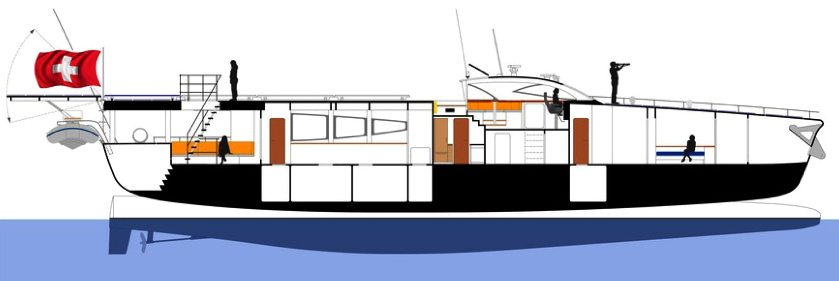
Design
concept -
Raphael
Domjan -
PROMOTIONAL
TOUR 2012
English - Swiss - French - History - Links - Homecoming
SOLAR
POWERED WATER SPEED RECORDS
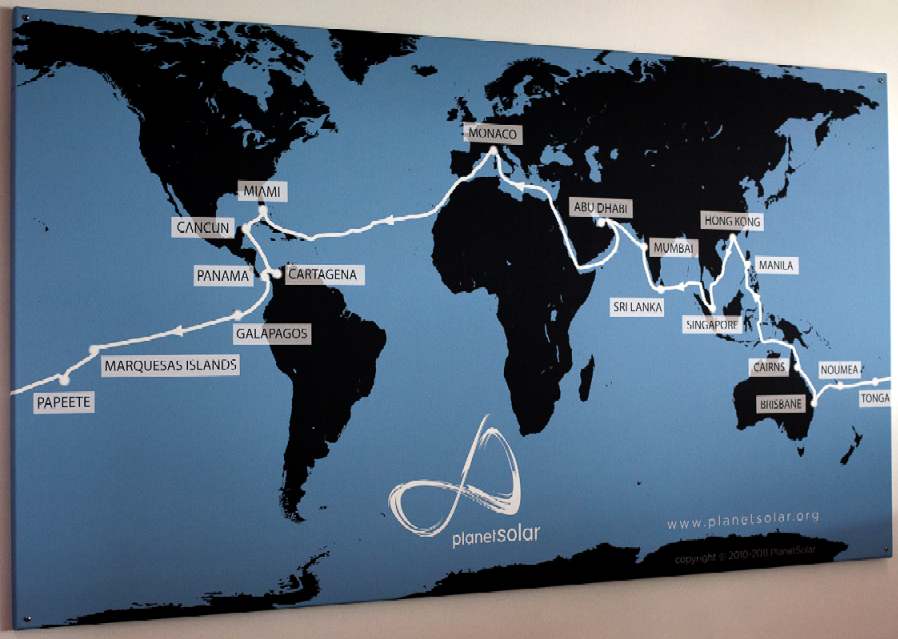
|
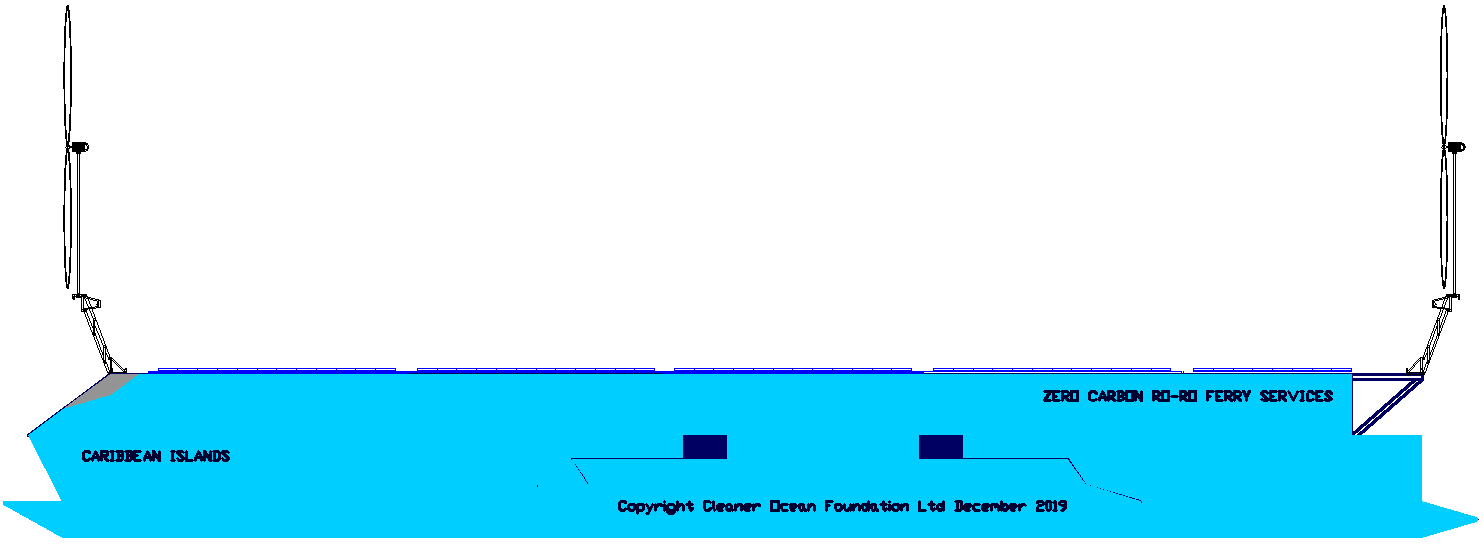
50M
ZERO CARBON RORO - This is a small roll-on roll-off ferry designed
to carry 12 large vans, with passenger rooms below decks. She is a zero
carbon design featuring twin wind generators that also add to thrust
directly from the wind (like sails) and a full deck of solar panels that
track the sun - including a battery store. The age of zero carbon
shipping is dawning, with designs like this leading the way.
Unfortunately, this vessel would cost significantly more to build than
the funding rate for this call. Hence, the proposal to develop a 16m
test-bed. If the pilot vessel is successful, designs like this
inter-island hopper could ensure sustainable coastal
tourism - without harming planet
earth. Design Copyright © December 6 2019.
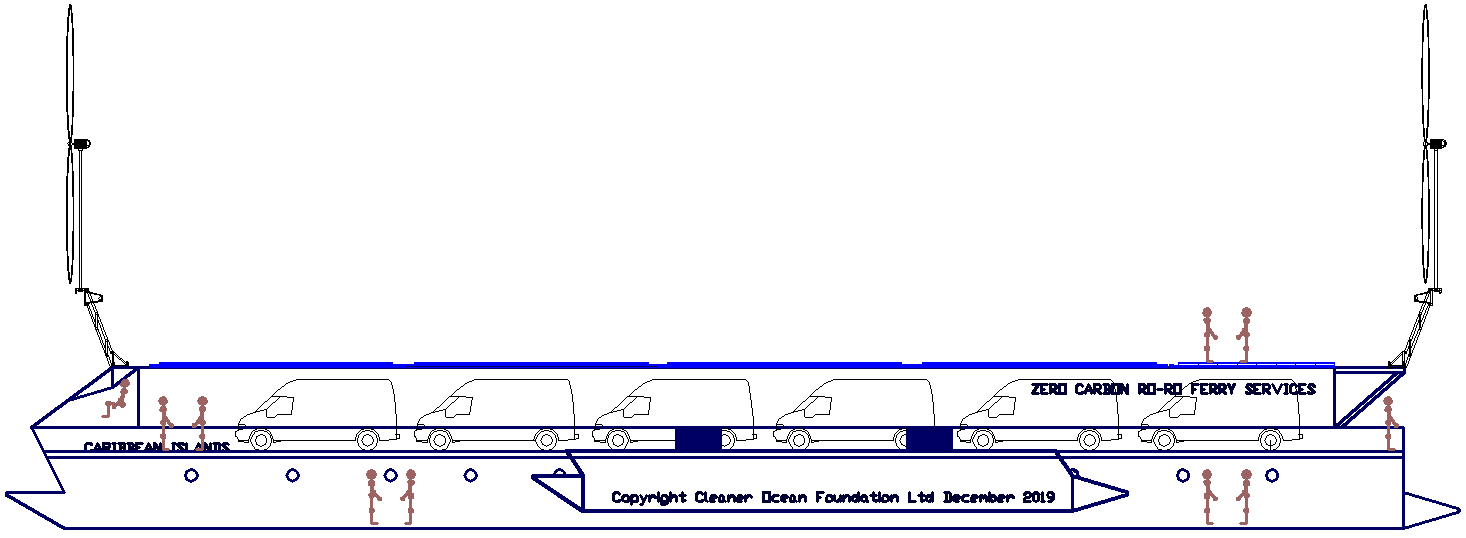
BLUE
BONDS - In 2018, the Seychelles launched the worlds very first
sovereign blue bond. That issuance was for a total of $15 million worth
of 10-year bonds for the purpose of protecting marine environments and
safeguarding fisheries.
In September 2019 the Pacific
Blue Shipping Partnership announced their intention to raise $400
million by issuing a blue bond. The coalition includes the governments
of Fiji, the Marshall Islands, Samoa, Vanuatu, the Solomon Islands and
Tuvalu. They have set an emissions reduction target of 40% by 2030, and
full decarbonisation by 2050.
Dr. Peter Nuttall, a scientific and technical adviser for the
Micronesian Center for Sustainable
Transport at the University of the South Pacific, says shipping is a
lifeline for every Pacific nation:
Without shipping, our economies die, our people cant survive.
In places like the Solomon Islands or the Marshall Islands, 80% to 90%
of all goods arrive by ship. We have the most expensive shipping in the
world, the longest transport routes, and the worst ships.
Dr. Nuttall added that nations in the Pacific cannot wait for the
rest of the world. We have to bespoke design a Pacific solution if it is
going to work, not leave the Pacific to languish." We offer
that the same situation applies to the Caribbean.
RO-RO
FERRY END ELEVATION - In these drawings we see a 50 meter RoRo ferry
that is designed to service tourism and deliver supplies between the
Caribbean Islands. The rotary sails provide a significant area, but may
be increased to improve performance. The turbines can be raised and
lowered to cope with different running conditions and furled for docking
in ports or during storm conditions. The main hull is not the ideal, but
a compromise shallow draft design - to accommodate two Ford Transit vans
side by side (12 in total). The passenger areas are below decks. The
outriggers provide stability against roll induced by the wind turbines.
Please note that these drawings are Design Copyright © December 6 2019,
and the hull configuration and energy harvesting system are patent
protected.
|
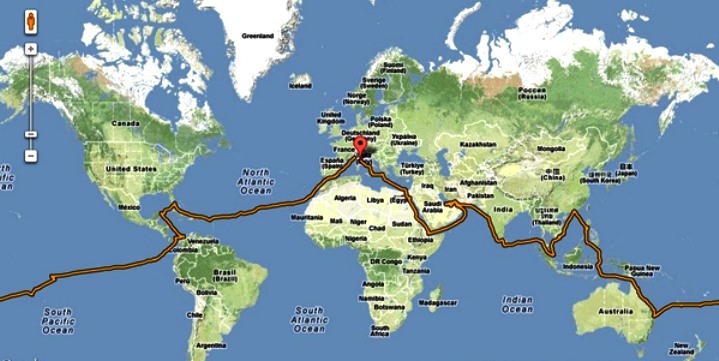
|
LEG
|
NAUTICAL
MILES
|
TIME
IN PORT
|
WAYPOINT
|
SUNSHINE
DAYS
|
|
-
|
-
|
-
|
-
|
-
|
|
|
-
|
-
|
Monaco
|
0.00
|
|
1
|
784
|
2
|
Gibraltar
|
4.67
|
|
2
|
729
|
2
|
Tenerife,
Canary Islands
|
4.34
|
|
3
|
3,154
|
2
|
Trinidad,
Port of Spain
|
18.77
|
|
4
|
1,182
|
2
|
Panama
City
|
7.04
|
|
5
|
970
|
2
|
Galapagos
|
5.77
|
|
6
|
3,640
|
2
|
Tahiti
|
21.67
|
|
7
|
1,423
|
2
|
Tonga,
Nukualofa
|
8.47
|
|
8
|
410
|
2
|
Fiji,
Suva
|
2.44
|
|
9
|
1,886
|
2
|
Port
Moresby PNG
|
11.23
|
|
10
|
340
|
2
|
Thursday
Island, Cape York
|
2.02
|
|
11
|
724
|
2
|
Darwin
|
4.31
|
|
12
|
1,572
|
2
|
Jakarta,
Indonesia
|
9.36
|
|
13
|
1,881
|
2
|
Colombo,
Sri Lanka
|
11.20
|
|
14
|
2,109
|
2
|
Aden,
Yemen
|
12.55
|
|
15
|
698
|
2
|
Jeddah,
Saudi Arabia
|
4.15
|
|
16
|
670
|
2
|
Port
Said, Egypt
|
3.99
|
|
17
|
1,111
|
2
|
Palermo,
Sicily
|
6.61
|
|
18
|
170
|
2
|
Naples,
Italy
|
1.01
|
|
19
|
393
|
|
Monaco
|
2.34
|
|
-
|
-
|
-
|
-
|
-
|
|
-
|
23,846
|
36
|
RUNTIME
DAYS @ 7kts
|
141.94
|
|
-
|
-
|
-
|
-
|
-
|
|
+
10% service
|
=
156.13 Days
|
-
|
7
KNOTS AVE INC PORT & %
|
192.13
|
|
-&
maintenance
|
-
|
-
|
AT
6 KNOTS AVE
|
224.16
|
|
-
|
-
|
-
|
AT
5 KNOTS AVE
|
268.99
|
TRANSIT
EXAMPLES - The above table illustrates one of the most likely
ocean awareness expedition routes that could be undertaken by the Elizabeth
Swan, showing the time elapsed in days for 7 knots average cruising
speed, including times for 5 and 6 knot averages - allowing for 10%
downtime and 36 days in ports. Hence, although the objective is to reduce
the current solar circumnavigation record from 584 days, the event in not
an outright non-stop yacht competition in the offshore racing sense. It
remains to be seen how accurate such a prediction might be.

A
heartwarming adventure: pirate whalers
V conservationists
with
a $Billion dollars riding on the conclusion.
|


















